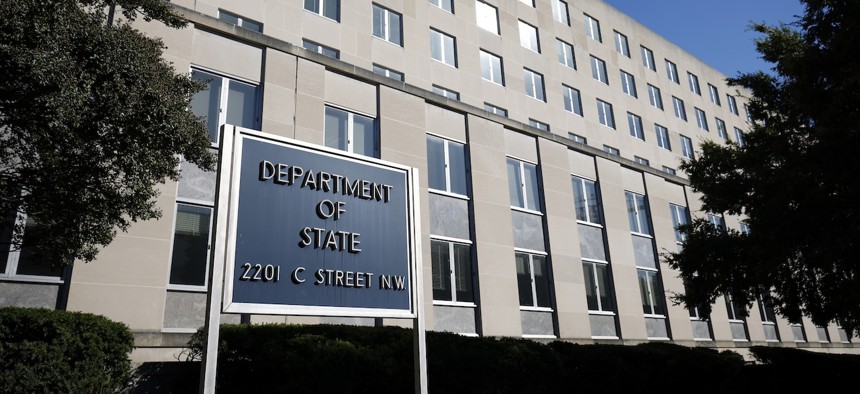State Dept. cuts poised to be more severe than previously outlined with 3,400 employees on the chopping block

Undersecretaries throughout the State Department are currently finalizing plans for their offices, which they must turn over by May 19. Kevin Dietsch/Getty Images
There were bipartisan concerns from lawmakers about a planned break-up of the Bureau of Cyberspace and Digital Policy, according to meeting notes. Office eliminations are expected by June 2.
The State Department’s upcoming staff cuts are more severe than they initially appeared and are expected to impact around 3,400 employees beginning in early June, according to the agency’s briefings with lawmakers and employees with knowledge of the matter.
The previously announced 132 office closures as part of Secretary Marco Rubio’s reorganization of State will lead to 700 jobs being eliminated. Only then will Rubio’s goal of 15% cuts go into effect, meaning an additional 2,700 employees will be subject to reductions in force or otherwise leave government. The details, which could be altered before final notices go out, were spelled out in State officials’ notes of the meeting obtained by Government Executive and corroborated by employees familiar with the meeting and the department’s plan.
The cuts will apply to both civil and foreign service positions, and foreign service officers impacted by the reductions are not expected to have the opportunity to re-bid for new roles. They will instead have to exit government, according to the briefers. Some current FSOs suggested that would not comply with the Foreign Affairs Manual and the briefers may have erroneously explained the situation.
Undersecretaries throughout State are currently finalizing plans for their offices, which they must turn over by May 19. By June 2, office eliminations will begin and RIF notices will start to go out. The reorganization will be fully implemented by July 1, according to the internal readout that was corroborated by multiple people.
Already, employees in both the office elimination tranche and in the larger, second tranche have begun to receive informal notifications their roles will be cut. Some foreign service officers who were preparing to start new roles in the coming weeks have been told those positions will no longer exist, employees said. That includes some staff in the Bureau of Energy Resources, for example, and employees set to embed in international organizations such as the World Trade Organization and United Nations.
State will not have to lay off all 3,400 employees they want to cut. While employees have reported hearing differing information on that issue, State officials told lawmakers it will count voluntary separations—such as those who leave through the latest “deferred resignation” offer—toward the cut goal. The reduction will focus on actual people, however, meaning eliminating an unfilled position will not count toward the total.
Layoffs are not expected to hit passport and visa processing with the Bureau of Consular Affairs. That bureau has around 2,400 domestic employees, about half of whom process passports, removing a large swath of the workforce from the RIF pool. Effectively, around 20% of the remaining positions will be eliminated.
The Senate Foreign Relations Committee, which received the briefing, did not return a request for comment. The meeting notes were provided to Government Executive from sources inside the executive branch.
As State previously laid out, the current round of layoffs will impact only domestic staff. The department told employees last month it had not yet determined whether it would close any embassies, consulates or overseas posts, though State officials briefing Capitol Hill staff said there were no current plans to close any of them. The officials said they could not confirm there would not be embassy closures in the future.
State has approved 200 positions to convert to Schedule Policy/Career—a designation formerly known as Schedule F that will make it easier to fire employees for politically motivated reasons—a relatively small figure relative to the approaches of some other agencies.
The department is set to eliminate all of its special envoys that are not mandated by law and currently filled. Some offices set for elimination will see their statutorily authorized staff transferred to other entities within State, such as some of the employees in the Global Women’s Issues employees. All functions with the Executive Secretariat will be consolidated within Rubio’s office.
Congressional staff told State officials some of their proposals would require legislative action and asked if the department would pursue that path, according to the briefing readout, but the officials said they had no plan to do so.
Various cybersecurity and intelligence units within the agency are expected to undergo changes, the readout stated. The Bureau of Cyberspace and Digital Policy—which focuses on advancing U.S. interests in cyberspace and developing stronger digital age alliances—is expected to be broken up, with three undersecretaries managing the office’s new tranches, Politico reported recently.
There were bipartisan concerns about breaking up that cyber office, according to the summary of the meeting. The bureau’s work focused on digital freedom will be incorporated into the office of the Under Secretary for Public Diplomacy and Public Affairs, the summary added.
All matters pertaining to security-related assistance will be consolidated under the Office of the Under Secretary for Arms Control and International Security. Additionally, analytical functions of the Bureau of Conflict and Stabilization Operations will be transferred into State’s Bureau of Intelligence and Research, an intelligence community office that protects the agency’s top secret networks and produces insights for diplomatic decisions.
That described change to the CSO office is not explicitly reflected in the department’s updated organizational chart. Similarly, the Office of Global Criminal Justice—described in the briefing as being reassigned to the Office of the Legal Adviser—does not appear on the chart.
Frank Konkel contributed to this report.
How are these changes affecting you? Share your experience with us:
Eric Katz: [email protected], Signal: erickatz.28
NEXT STORY: Palantir alum appointed to top tech role at HHS





